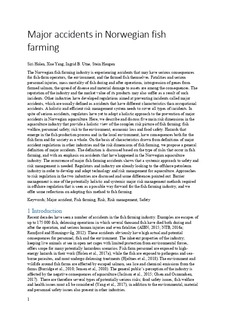| dc.contributor.author | Holen, Siri Mariane | |
| dc.contributor.author | Yang, Xue | |
| dc.contributor.author | Utne, Ingrid Bouwer | |
| dc.contributor.author | Haugen, Stein | |
| dc.date.accessioned | 2020-01-06T09:35:06Z | |
| dc.date.available | 2020-01-06T09:35:06Z | |
| dc.date.created | 2019-09-24T12:06:15Z | |
| dc.date.issued | 2019 | |
| dc.identifier.citation | Safety Science. 2019, 120 32-43. | nb_NO |
| dc.identifier.issn | 0925-7535 | |
| dc.identifier.uri | http://hdl.handle.net/11250/2634930 | |
| dc.description.abstract | The Norwegian fish farming industry is experiencing accidents that may have serious consequences for fish-farm operators, the environment, and the farmed fish themselves. Fatalities and serious personnel injuries, mass mortality of fish during and after operations, introgression of genes from farmed salmon, the spread of disease and material damage to assets are among the consequences. The reputation of the industry and the market value of its products may also suffer as a result of such incidents. Other industries have developed regulations aimed at preventing incidents called major accidents, which are usually defined as accidents that have different characteristics than occupational accidents. A holistic and efficient risk management system needs to cover all types of incidents. In spite of serious accidents, regulators have yet to adopt a holistic approach to the prevention of major accidents in Norwegian aquaculture. Here, we describe and discuss five main risk dimensions in the aquaculture industry that provide a holistic view of the complex risk picture of fish farming; fish welfare, personnel safety, risk to the environment, economic loss and food safety. Hazards that emerge in the fish production process and in the local environment, have consequences both for the fish farm and for society as a whole. On the basis of characteristics drawn from definitions of major accident regulations in other industries and the risk dimensions of fish farming, we propose a general definition of major accidents. The definition is discussed based on the type of risks that occur in fish farming, and with an emphasis on accidents that have happened in the Norwegian aquaculture industry. The occurrence of major fish farming accidents shows that a systemic approach to safety and risk management is needed. Regulators and industry are already looking to the offshore petroleum industry in order to develop and adapt technology and risk management for aquaculture. Approaches to risk regulation in the two industries are discussed and some differences pointed out. Barrier management is one of the potentially holistic and systemic major risk management methods required in offshore regulation that is seen as a possible way forward for the fish farming industry, and we offer some reflections on adopting this method to fish farming. | nb_NO |
| dc.language.iso | eng | nb_NO |
| dc.publisher | Elsevier | nb_NO |
| dc.rights | Attribution-NonCommercial-NoDerivatives 4.0 Internasjonal | * |
| dc.rights.uri | http://creativecommons.org/licenses/by-nc-nd/4.0/deed.no | * |
| dc.title | Major accidents in Norwegian fish farming | nb_NO |
| dc.type | Journal article | nb_NO |
| dc.type | Peer reviewed | nb_NO |
| dc.description.version | acceptedVersion | nb_NO |
| dc.source.pagenumber | 32-43 | nb_NO |
| dc.source.volume | 120 | nb_NO |
| dc.source.journal | Safety Science | nb_NO |
| dc.identifier.doi | 10.1016/j.ssci.2019.05.036 | |
| dc.identifier.cristin | 1728269 | |
| dc.relation.project | Norges forskningsråd: 254913 | nb_NO |
| dc.description.localcode | © 2019. This is the authors’ accepted and refereed manuscript to the article. Locked until 2022 due to copyright restrictions. This manuscript version is made available under the CC-BY-NC-ND 4.0 license http://creativecommons.org/licenses/by-nc-nd/4.0/ | nb_NO |
| cristin.unitcode | 194,64,20,0 | |
| cristin.unitname | Institutt for marin teknikk | |
| cristin.ispublished | true | |
| cristin.fulltext | original | |
| cristin.fulltext | postprint | |
| cristin.qualitycode | 1 | |

